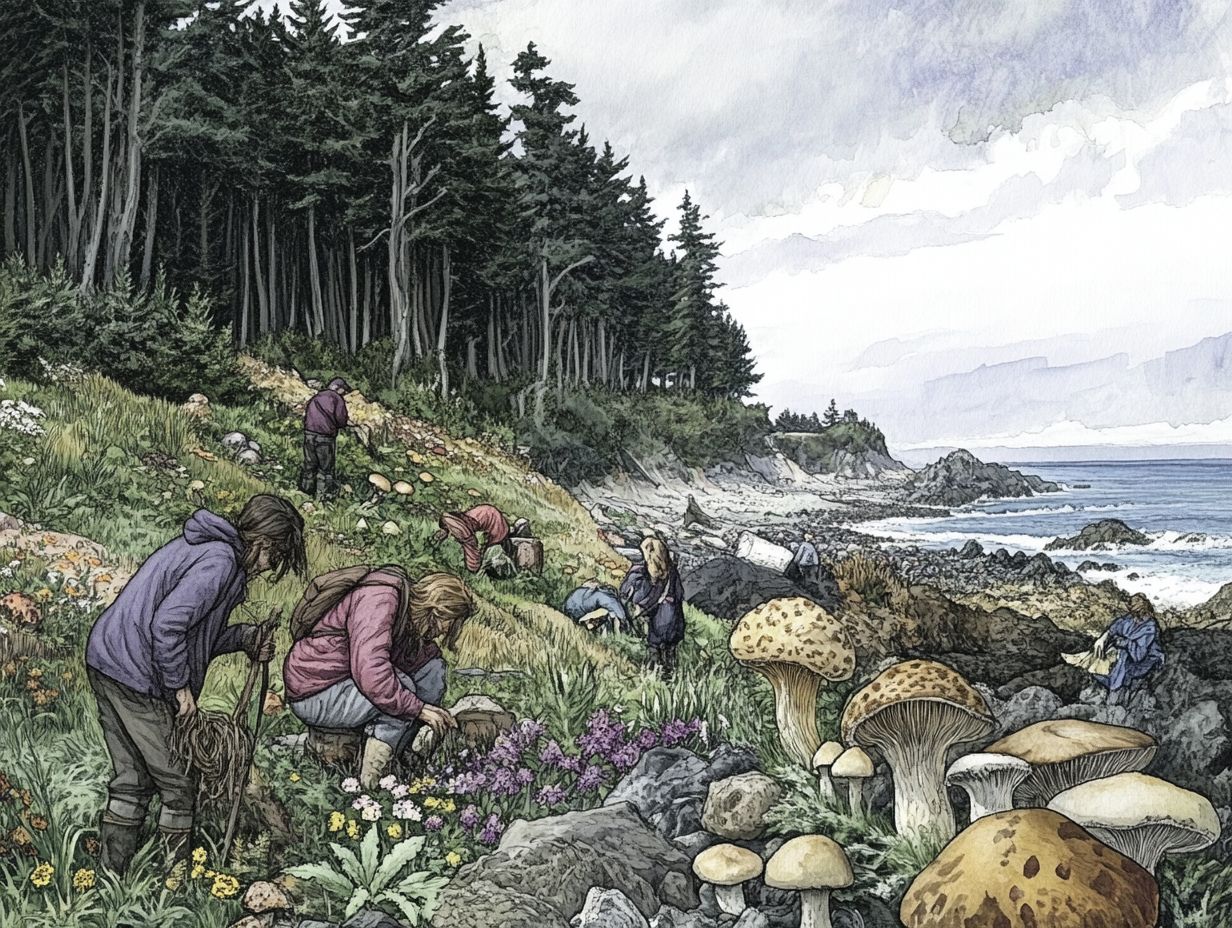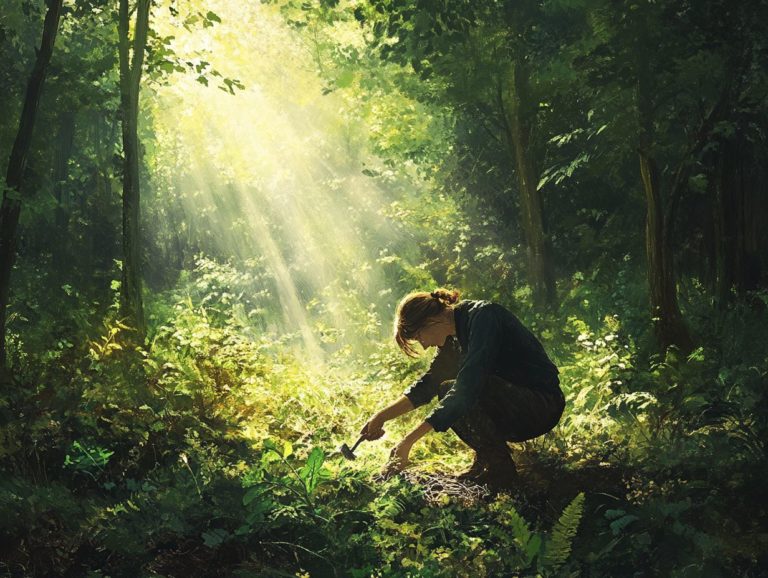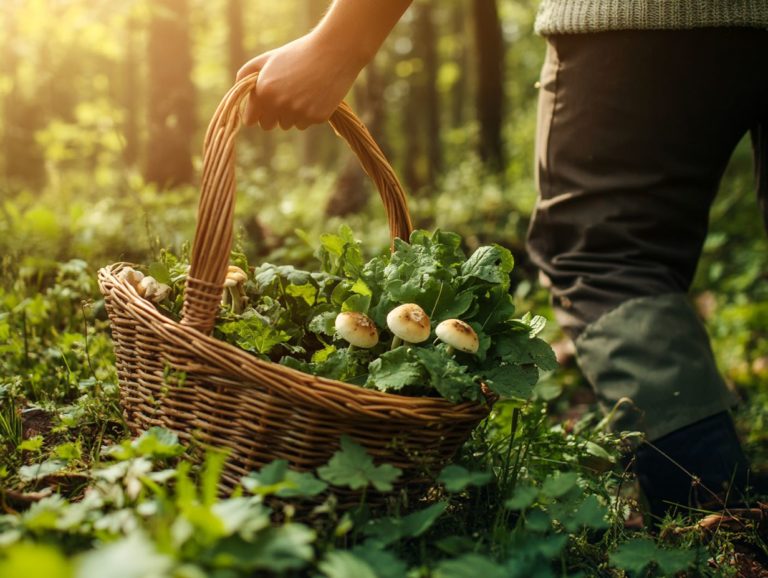Foraging Techniques for Different Ecosystems
Foraging transcends mere trend; it s an ancient practice that reestablishes your connection with nature and its abundant offerings.
As you wander through lush forests, explore coastal shores, or navigate arid deserts, each ecosystem unveils unique edible treasures just waiting for your discovery.
This article delves into essential foraging techniques, identifies common plants and fungi, and provides invaluable tips for successful harvesting across diverse environments.
Get ready to discover amazing wild flavors and learn the art of foraging responsibly and safely!
Contents
- Key Takeaways:
- Basic Foraging Techniques
- Foraging in Forest Ecosystems
- Foraging in Coastal Ecosystems
- Foraging in Desert Ecosystems
- Frequently Asked Questions
- What are foraging techniques and why are they important for different ecosystems?
- What are some common foraging techniques used in different ecosystems?
- How do foraging techniques differ in different types of ecosystems?
- How do animals adapt their foraging techniques to survive in different ecosystems?
- What are the potential consequences of using the wrong foraging techniques in an ecosystem?
- How can understanding foraging techniques in different ecosystems help with conservation efforts?
Key Takeaways:
- Foraging means searching for and collecting food from nature.
- Knowing the right tools and edible plants is vital for success.
- Each ecosystem has unique foraging techniques, like finding seaweed on the coast or being cautious in deserts.
What is Foraging?
Foraging is your gateway to connecting with nature, allowing you to search for and gather wild food resources a vital survival skill that both humans and animals have relied on for millennia.
It requires you to understand the behaviors of various species, including a fascinating array of birds and their unique foraging techniques.
From the opportunistic foragers like the Black Skimmers to the ingenious tool-using New Caledonian crows, each species showcases a distinct approach.
Foraging embodies the principles of optimal foraging theory (the idea that animals try to find food in the most efficient way possible), where the balance of energy spent searching and maximizing nutritional intake is paramount.
Different bird species have tailored their foraging strategies to thrive in diverse environments.
Take the American robin, for example; its exceptional eyesight allows it to spot worms and insects in the ground with remarkable precision.
On the other hand, the European magpie displays clever strategies that often involve complex problem-solving skills, especially when it comes to retrieving hidden food.
These behaviors show how energy efficiency and resource availability shape not only avian diets but also inform human hunting and gathering practices.
By examining these varied foraging models, you can uncover valuable insights into ecological dynamics and the intricate relationships between species and their environments.
Basic Foraging Techniques
Basic foraging techniques for sustainable living encompass a variety of methods that allow you to efficiently locate and capture meals while minimizing risks from predators.
These techniques can differ significantly among species, showcasing adaptations that have evolved over time to enhance survival and energy efficiency.
Take birds, for example; they showcase an impressive array of hunting strategies.
From the dramatic plunge-diving of Brown Pelicans to the meticulous probing behaviors of the Secretarybird and Oxpeckers, which target parasitic invertebrates on mammals, there’s a world of foraging finesse waiting to be explored.
Tools and Equipment
Tools and equipment significantly enhance the efficiency of foraging techniques, especially among species like the Woodpecker Finch, which cleverly employs cactus spines to extract insects from tree bark.
These specialized tools reveal the innovative capabilities of birds that create or adapt items to meet their dietary needs, showcasing remarkable problem-solving skills and dexterity.
This behavioral adaptation isn t exclusive; other species, such as the New Caledonian Crow, adeptly use sticks to extract insects from crevices, illustrating the complexity of their cognitive abilities.
Sea otters bring a different flair to the table as they utilize rocks to crack open shellfish, highlighting the diverse array of tool use across the animal kingdom.
The emergence of such foraging strategies indicates an intrinsic understanding of their environment, enabling these creatures to optimize their hunting efficiency.
Whether it s the intricate dance of choosing the perfect tool or the innovative crafting of equipment, the versatility displayed by these species highlights an evolutionary advantage that sharpens their survival skills.
Identifying Edible Plants and Fungi
Identifying edible plants and fungi is a vital skill for foraging. This knowledge helps you get the nutrition you need while avoiding harmful varieties.
It s not just for wild areas; even urban settings can be rich in foraging opportunities. Backyard plants can attract birds, enhancing your experience.
Start with field guides or smartphone apps to help you tell edible from inedible species. Focus on familiar places like parks or gardens.
Observing growth patterns, habitat preferences, and seasonal changes provides invaluable insights into which plants and fungi might be safe to consume.
Stay vigilant about toxicity. Some species may look similar but can be harmful if eaten. Join local foraging groups to deepen your understanding.
Foraging in Forest Ecosystems
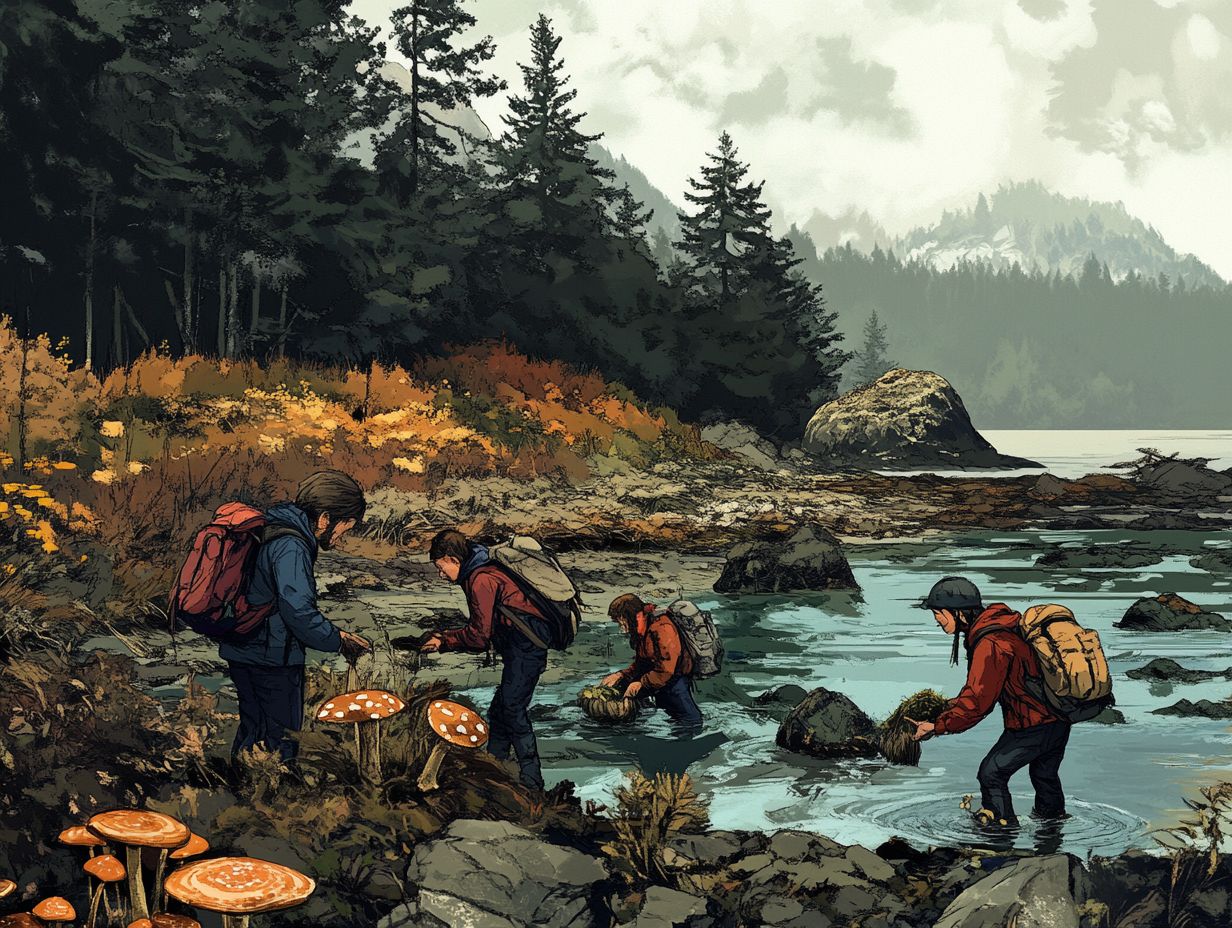
Foraging in forest ecosystems means using special techniques to find and collect food. You can discover various edible plants and fungi that thrive in these rich environments by applying foraging techniques for rural areas.
Understanding how predators and prey interact in forests will boost your foraging efforts. This ensures a responsible approach to gathering food.
Common Edible Plants and Fungi
In forest ecosystems, common edible plants and fungi include species like wild mushrooms, berries, and nuts. These offer rich nutritional benefits.
Apply the principles of optimal foraging theory to enhance your harvesting techniques. Understanding growth patterns and seasonal availability lets you plan effective foraging strategies.
As early spring arrives, get ready to explore the forest floor for tender ramps and morels. Both are known for their unique flavors and impressive vitamin content.
When summer arrives, wild blueberries and blackberries ripen, providing a fantastic source of antioxidants. In fall, enjoy a bounty of acorns and hazelnuts. These are delicious and rich in healthy fats and proteins.
Embrace the principles of optimal foraging theory. Focus on energy efficiency and maximizing returns to enhance your harvest.
This approach fosters a harmonious relationship with the ecosystem. It deepens your appreciation for nature s seasonal rhythms and nutritional treasures.
Techniques for Finding and Harvesting
Locating and harvesting edible resources in forest ecosystems involves keen observation and practical skills. Learn to recognize subtle signs of plant growth and animal activity.
Understanding concepts that show how available resources change based on competition helps optimize your foraging efforts.
As you refine your observational skills, notice the subtle cues in your environment. Look for signs of wildlife or shifts in vegetation patterns that indicate nearby edible plants or animals.
This knowledge is valuable and enables you to adapt your foraging strategies. Gaining a deeper understanding of these dynamics boosts your gathering techniques.
It promotes sustainable practices, benefiting both the ecosystem and future foragers like you.
Foraging in Coastal Ecosystems
Get ready for an exciting adventure! Foraging in coastal ecosystems offers a wealth of resources, from delectable seaweed to succulent shellfish. Each requires smart strategies suited to the marine environment.
By employing these smart strategies, you can significantly enhance your catch while minimizing the effort and time spent gathering these nutritious treasures from the sea.
Edible Seaweed and Shellfish
Edible seaweed and shellfish are among the most coveted resources in coastal ecosystems. They’re celebrated not only for their unique flavors but also for their impressive nutritional benefits. These marine treasures do more than enhance local diets; they hold a significant place in traditional cuisines around the globe.
You ll find common varieties of edible seaweed, such as nori, dulse, and wakame. Each offers distinct tastes and textures, perfect for incorporating into salads, soups, or sushi. Similarly, shellfish like clams, mussels, and shrimp are beloved for their rich protein and omega-3 fatty acid content.
As you start your foraging adventure, remember to use sustainable methods. Timing your harvest with low tides is one great way to do this. This not only helps maintain healthy populations but also enriches your overall gathering experience.
By learning to identify these species and understanding the seasons they flourish in, you can significantly enhance your foraging skills and culinary outcomes.
Best Times and Locations for Foraging
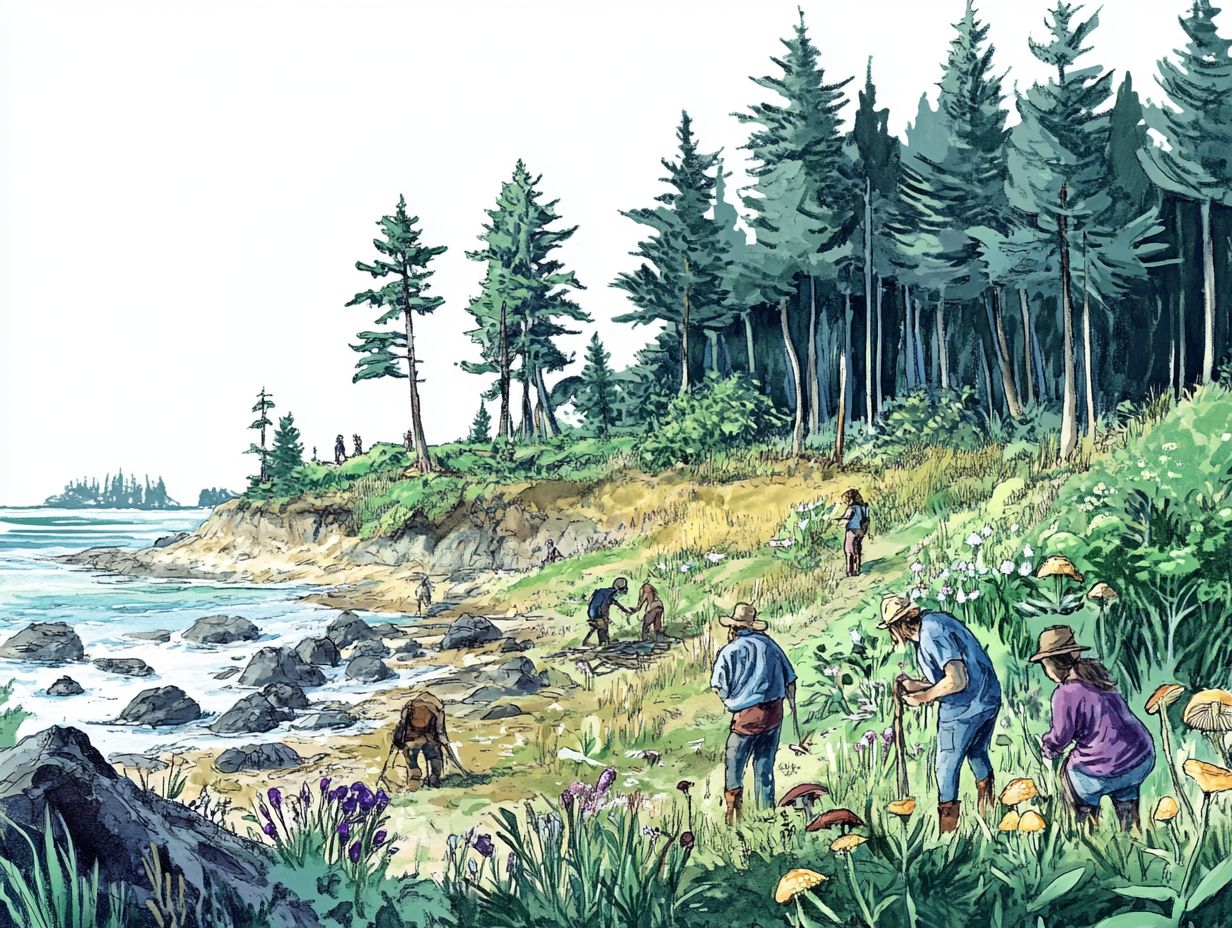
To maximize your catch and nutrition, knowing the best times and places to forage is key. Factors like tides and seasons greatly influence resource availability, so it s important to be strategic.
Understanding the ebb and flow of tides is crucial, as many marine resources become more accessible during low tide. Seasonal shifts can dictate the abundance of specific species, making it vital to stay informed about local patterns. Grasping predator-prey dynamics can help you choose areas where prey is more plentiful and less endangered.
Plan your trips around the lunar cycle. The best foraging opportunities often arise shortly after a new moon or full moon when tides are at their most pronounced. Engaging with local communities offers valuable insights into optimal foraging spots and seasonal fluctuations.
Foraging in Desert Ecosystems
Foraging in desert ecosystems demands specialized techniques to effectively locate and harvest the edible plants vital for survival in such arid environments. Familiarizing yourself with foraging techniques for wilderness survival is essential, as the harsh climate shapes available resources and requires a deep understanding of the local flora and their nutritional properties.
Mastering these skills not only enhances your foraging success but also equips you to navigate the challenges posed by this unique landscape.
Survival Techniques and Edible Plants
Survival techniques for foraging in desert ecosystems require you to identify a variety of edible plants that can provide both hydration and nutrition, such as cacti and other succulents. Mastering foraging techniques for outdoor enthusiasts can make all the difference between sustenance and starvation in these demanding environments.
In these arid landscapes, you’ll encounter resilient plants, including prickly pear and various cacti, which offer not only water-rich flesh but also nutrient-dense fruit. You might also explore wild herbs and leafy greens that thrive in dry conditions.
To maximize your efficiency in gathering these vital resources, it’s essential to learn how to recognize the distinct signs of edible plants, such as unique leaf shapes and their flowering periods.
Understanding the seasonal availability of these plants and utilizing tools like digging sticks or baskets can greatly enhance your foraging success, especially when you apply understanding regional foraging techniques, turning what may seem like a barren landscape into a treasure trove of life-sustaining nutrition.
Precautions for Foraging in the Desert
Precautions for foraging in the desert are essential to ensure your safety while navigating potential hazards, such as toxic plants and extreme weather conditions. Understanding the local ecology, including which plants are safe to consume, is crucial for a successful foraging experience.
Before you embark on a foraging adventure, familiarize yourself with the local plants and animals. Pay special attention to harmful species like the notorious castor bean and oleander. Carrying a reliable field guide can be invaluable for identifying edible versus toxic plants.
For the best experience, explore well-known areas with an expert! Prioritize hydration, as dehydration can cloud your judgment and lead to unsafe decisions. Stay cautious and informed to enjoy the unique offerings of the desert while reducing risks.
Frequently Asked Questions
What are foraging techniques and why are they important for different ecosystems?
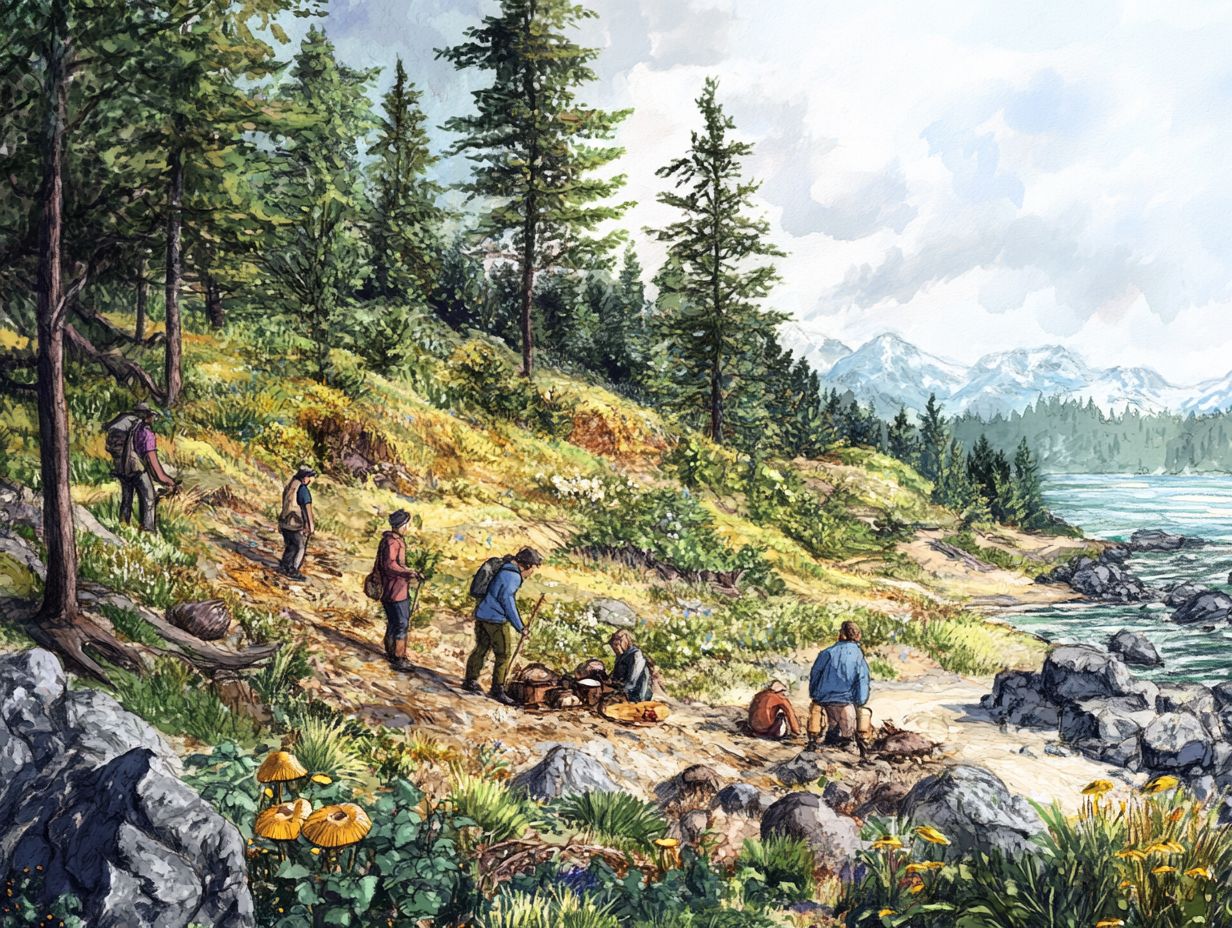
Foraging techniques refer to how animals search for and acquire food in their natural habitats. Understanding foraging techniques for urban environments is important because they allow animals to find the necessary nutrients for survival.
What are some common foraging techniques used in different ecosystems?
Common foraging techniques include browsing, grazing, scavenging, and hunting. Browsing involves eating leaves, shoots, and other plant parts, while grazing means eating grasses and low-lying vegetation. Scavenging is the act of eating remains of dead animals or plants, and hunting involves capturing and killing prey. For a deeper understanding, you can explore foraging techniques for sustainable practices.
How do foraging techniques differ in different types of ecosystems?
Foraging techniques vary in ecosystems based on food availability and animal types. For example, in a forest ecosystem, animals may climb or dig for food, while in a marine ecosystem, they may dive or use filter feeding techniques. To learn more, explore foraging techniques from around the world.
How do animals adapt their foraging techniques to survive in different ecosystems?
Animals evolve their foraging techniques to survive in different environments. For instance, animals in dry areas may have longer tongues and specialized digestive systems to extract water from food. In contrast, animals in cold climates might have thicker fur and larger body sizes to conserve heat.
What are the potential consequences of using the wrong foraging techniques in an ecosystem?
Using improper foraging techniques can lead to negative consequences. For example, overgrazing can cause soil erosion and loss of plant species diversity, while excessive hunting or scavenging can disrupt predator-prey relationships.
How can understanding foraging techniques in different ecosystems help with conservation efforts?
Understanding foraging techniques aids conservation by revealing the relationships between animals and their food sources. Exploring foraging in different seasons can inform management plans to protect and preserve habitats and species.

